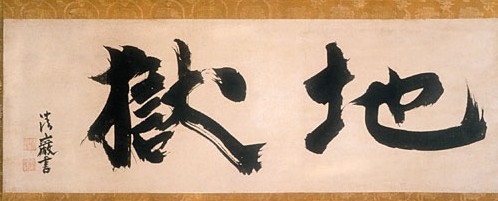|
|
|
Seigan Soi, 1588-1661
This calligraphy, reading Hell, was probably for hanging in a tea room.
It's one of the most powerful, vigorous works I've ever seen, and has
great use of what is known as 'flying white' - when the strands of the
drying brush separate to leave unmarked trails, as in the diagonal left
of centre here. I compared Ichiran's mandala (at the start of this Zen
section) to medieval European devotional paintings of saints; this seems
similarly to parallel the Catholic taste for drumming scary visions of
damnation into its worshippers - instead of a Bosch (or, of course, in fact
as well as - see the Scroll of
Hell) the Japanese went for a calligraphy equivalent.
backwards: Ikyu
|
|

